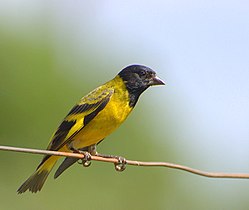| Hooded siskin | |
|---|---|
 | |
| Male near Piraju (São Paulo, Brazil) | |
| Spinus magellanica - Hooded Siskin (song) | |
| Scientific classification | |
| Kingdom: | Animalia |
| Phylum: | Chordata |
| Class: | Aves |
| Order: | Passeriformes |
| Family: | Fringillidae |
| Subfamily: | Carduelinae |
| Genus: | Spinus |
| Species: | S. magellanicus |
| Binomial name | |
| Spinus magellanicus (Vieillot, 1805) | |
 | |
| Synonyms | |
Sporagra magellanica Contents | |
The hooded siskin (Spinus magellanicus) is a small passerine bird in the finch family (Fringillidae), native to South America. It belongs to the putative clade of neotropical siskins in the genus Spinus sensu lato.
There are 11 subspecies, including the Santa Cruz hooded siskin (S. m. santaecrucis) of central and eastern Bolivia. This subspecies is sometimes considered to be a separate species.


